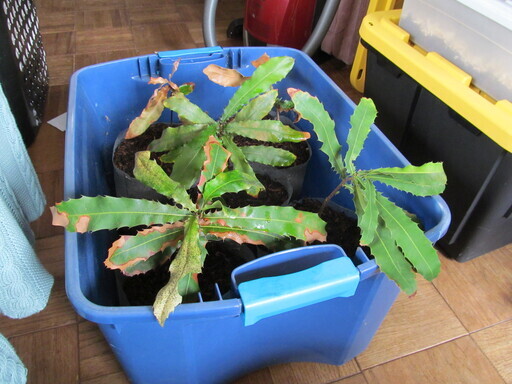The Sweet Lorane Fava beans in the front yard are flowering now.

The Sweet Lorane Fava beans in the front yard are flowering now.

Safflower (Carthamus tinctorius) from some birdseed I tossed out to grow “green mulch”. Some sort of gopher has eaten almost all of them, but this muscular and multi-crowned beastie has been left alone, so far…

Mullien (Verbascum Thapsus) growing in a planter, flowering. It’s starting to grow some side shoots with more flowers. This in in Park Merced out by the Pacific ocean, cold and foggy. (Seed from J. L. Hudson, from 2021)

Chocolate trees, I’m not so much growing them as slowly killing them, but they’re still alive and I have high hopes.
On the left is an Inga feuillei (Ice Cream Bean). It’s very happy, growing lots of little shoots and a few big ones. I bet it would make adventitious roots, eh? Quick and easy propagation if so…
I enclosed a metal shelving unit with greenhouse plastic, put a heater on the bottom with fish tank full of water and a towel hanging down into it to make a simple swamp cooler to modulate the heater and increase the humidity. It worked really well until the towel dissolved!
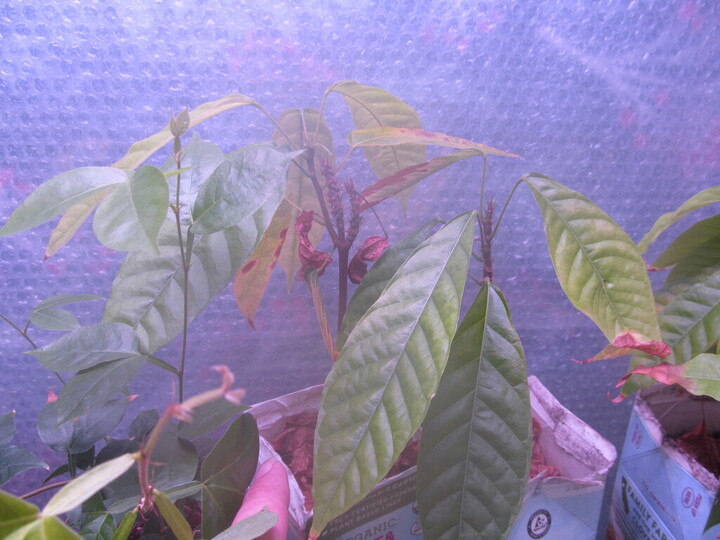

Thistle and rocks. This kind of land would discourage some people, but I see resource: plenty of rocks and rich loam. Lots of green biomass to compost. I love it.

A couple of the Sebrights explore their environment.

Have you ever seen such a kale? It’s a kale/collard cross that has been grown in San Francisco for several generations (of kale, not humans.) The seeds for this tree were originally given to me by one Kevin Bayuk, currently of LIFT Economy (https://www.lifteconomy.com/) who called them “perennial brassica crosses” and they live up to the name. This tree was planted about two-and-a-half years ago. There are some others around the corner but they have a bushy habit. This one is clearly expressing some Walking Stick kale genes or something, eh?
I’m pretty sure Park Merced will come in and remove all of this once we leave. The landscapers themselves are cool, but mgmt wants the place to look like LEGO land. It’s a race against time for those seed pods to ripen before they tree gets the ax.
Anyway, life goes on. I’ve given away seeds from previous generations and there are lots of little plants here and there. If you look closely at the lower left corner you can just see the edges of the leaves of another one, it has purple stems! Same seeds.
A lot of other stuff going on in this photo. From left to right on the ground there is a bunch of safflower that are just there from bird seed I tossed out. Ground cover and mulch, yeah? They are doing really well.
(The little bush with the red leaves is Park Merced’s, I don’t know what it is but it’s tough.)
Then there are a few Sweet Lorane fava beans, fourth generation here. They have adapted well. Bugs eat the leaves but they don’t care, they just outgrow all damage.
Then there’s that tree (the tree-tree not the kale-tree), you can see it has been maintained with great expertise, by a doctor. Dr. Seuss.
At the base of the tree we have a wild pile of all kinds of things, a few I planted but mostly wild stuff I collected from nearby.
You can see the fuzzy tufted heads of the bunny tail grass (Lagurus ovatus), that’s the second year it’s grown from that spot. Perennial, eh? The little purple flowers are (I’m pretty sure) Little-Robin (Geranium purpureum). You can see another brassica cross in there, as well as some random wild plants with oval leaves. There’s a carrot in there bolting, I think it’s Pusa Asita (“Tropical Black”) but we’ll see. Same thing as the kale: race against time to ripen the seeds before the landscapers make it “nice” again.
Last but not least, there’s a nice big dandelion, because I like dandelions.
On the right there’s a Monkey Grass (Liriope) I found in the dumpster. It would be happier if I buried it deeper but at least it’s not in the dumpster.
The strawberries on the ground are beach strawberry (Fragaria chiloensis) from around Lake Merced. They send runners out aggressively and make a thick ground cover. They flower but rarely make berries. If the landscapers don’t remove it completely it will eventually cover the whole area.
Whew! So that’s what’s happening in that picture. This is about half of all the space I have (had) at our old place, and technically I wasn’t supposed to use it at all. I’ve been pent up people, is what I’m saying.
That bit of grass in the back against the wall: panic veldtgrass (Ehrharta erecta). “Native to Southern Africa and Yemen” it’s a beast here. It continuously goes to seed, the seeds are tiny and numerous, it spreads also by runners, etc. I thought it was indestructible until I saw what chickens do to it. I’ll post a picture later of a plant that grew on our concrete stair case! It started with a bit of schmutz and just didn’t die and now it’s the size of a basketball. It’s literally growing on concrete.

There’s a lot going on in this photo, let’s break it down. This is the temporary brooder set up in a corner of my room (all cleared out because I’m packing up to go to Green Hills.) You can see it’s divided into two sections. The smaller section on the lower left with the little hillock in it is for the Golden Sebrights, and the larger pen is for the Azure Eggers (you can just see a couple of them over the edge of the plastic tarp.)
In the lower left corner of the image there are three Sebrights napping on the edge of the cardboard box! They like it. I don’t understand how it works, I know there is some special roosting ability in chicken legs, but it’s impressive. I couldn’t nap sitting on a fence.
I put several different roosts along the edge of the brooder: a paper towel tube cut and rolled a little tighter/smaller than normal with a paper towel around it to offer traction; a length of stick; and a wooden paint stirrer (never used on paint, I mixed soil with it.) Still, they like just the edge of cardboard.
In the back in the corner is the box that the eggers sleep in at night, and on the right you can see the prototype of my simple computer system that I’m building. I have since had to cover that up, the eggers started jumping up there. It’s incredible how fast chickens grow. Each day they seem to “level up” and are ready for new things. I can’t wait to get them up to the land and let them run around (inside their respective runs, of course.)
That reminds me, having the two flocks next to each other like this should hopefully let them get used to each other as kids, and curtail inter-flock aggression when they grow up. The Sebrights are about twice as old as the eggers now, but they’re bantam so the eggers are already a little larger, and much heavier. The Sebrights mostly ignore the eggers, who, frankly, are obnoxiously frightened of me and them and everything that isn’t clearly food. Once in awhile one of the eggers will jump up onto the roost and then look around nervously at the Sebrights, who look back like, “Uh-huh, now what?”
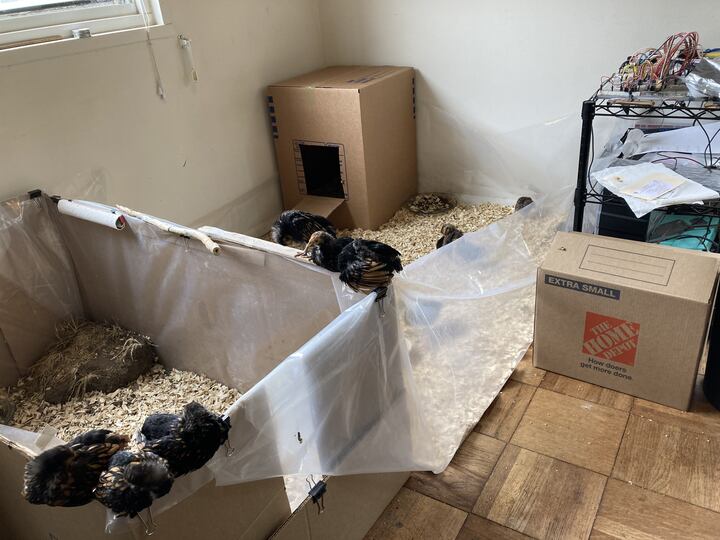
A local hatchery had these Golden Sebright chicks coming up for sale. I looked them up and they were so beautiful, so I ordered them w/o really doing much research. It turns out that they have a really interesting history, but they are not a great bird from the point-of-view of farm production. They’re basically a show bird. Too late now, I already love them.
Here they are as lil chicks, and then again at about three weeks. That was a couple of days ago. (I just now realized how to get images from my phone to my computer! So much for being a hotshot computer nerd, eh?)
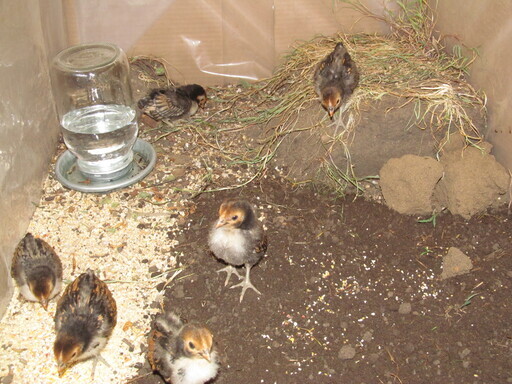
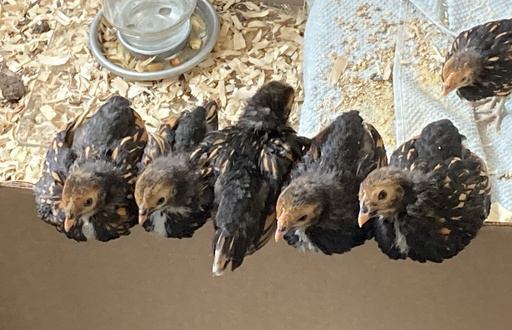
Let’s see, I got these Macadamia tetraphylla nuts from J.L. Hudson back in May 2021 and planted them in some air-prune mesh bags. Here they are, two years on, having put up with being essentially houseplants. Too dark and too dry and probably too cold. But they’re tough. Now they’re all packed up and ready to go.
I thought I killed that one tree but it has sprouted a new crown of leaves. Whew!
